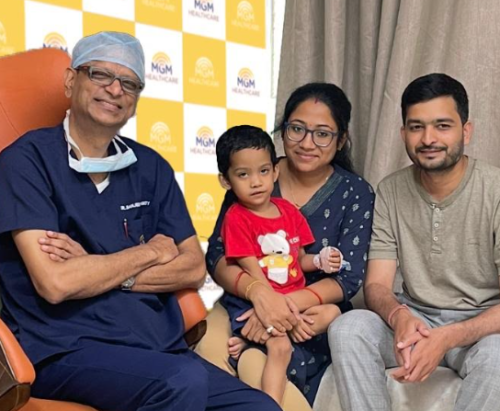Chennai, 19th June, 2025: MGM Healthcare successfully performed a Transnasal Endoscopic Repair of Cerebrospinal Fluid (CSF) Leak from a herniated brain inside nose with Skull Base Defect Reconstruction on a one-year-old child from Odisha. , marking a rare and complex intervention in pediatric endoscopic skull base surgery. This surgery was done using duragen, a collagen-based biomaterial, instead of a traditional autograft. The surgery was uneventful, the patient was discharged 48 hours post-surgery.

Cerebrospinal fluid (CSF) leakage occurs when there is a defect or tear in the protective membranes surrounding the brain and spinal cord, allowing the clear, cushioning fluid to escape from its normal pathways. When such a leak occurs at the skull base, it can lead to nasal discharge, recurrent infections, and breathing difficulties.The presence of congenital meningomyocele inside the nasal cavity proved to be the biggest surgical challenge . The condition is extremely rare, occurring in approximately 1 in 10,000 cases.
In this case, the child had been experiencing multiple episodes of brain fever, persistent CSF leakage and complete nasal blockage for nearly six months, due to a congenital skull base defect. This is a rare condition where the base of the skull does not fully develop during the growth period. If left untreated may lead to life-threatening complications due to the exposure of prolapsed meninges herniating into the nasal cavities from above. It was left undiagnosed and untreated till the pertinent investigations clinched the diagnosis. In the earlier visits to the hospitals, the baby was treated conservatively in the hope that mouth breathing would abate as the age progresses.Finally , a proper evaluation led to the diagnosis of this clinical entity.
The intra operative innovation using collagen based artificial dura eliminated the requirement for a secondary surgical site, thereby reducing surgical invasiveness, an important consideration in pediatric surgical care. In such an underweight child, especially , during the growth phase , it’s important to preserve the existing anatomy to the extent possible.
Prof. Dr. Sanjeev Mohanty, Senior Consultant and Head of the Department, Institute of ENT, MGM Healthcare said, “Navigating through a narrow transnasal route in a one-year-old child with such a high-risk skull base defect is always a surgical challenge. This case reinforces the importance of early diagnosis and timely intervention. Open surgical approaches in such cases can be highly morbid. However, by employing the endoscopic technique along with advanced biomaterials, we were able to minimize scarring, ensure faster recovery, and reduce the overall surgical burden on the child.”
Using advanced high-definition endoscopic imaging technology, Dr. Mohanty and his team successfully navigated the infant’s extremely narrow nasal passage to locate and repair the skull base defect with high precision.
This case also underscores the value of cadaveric dissection-based training and continual upskilling in endoscopic skull base approaches, which enhance surgical precision and enable safer, more effective treatment of rare and complex cases like this one.
Leave a Reply